Setup:
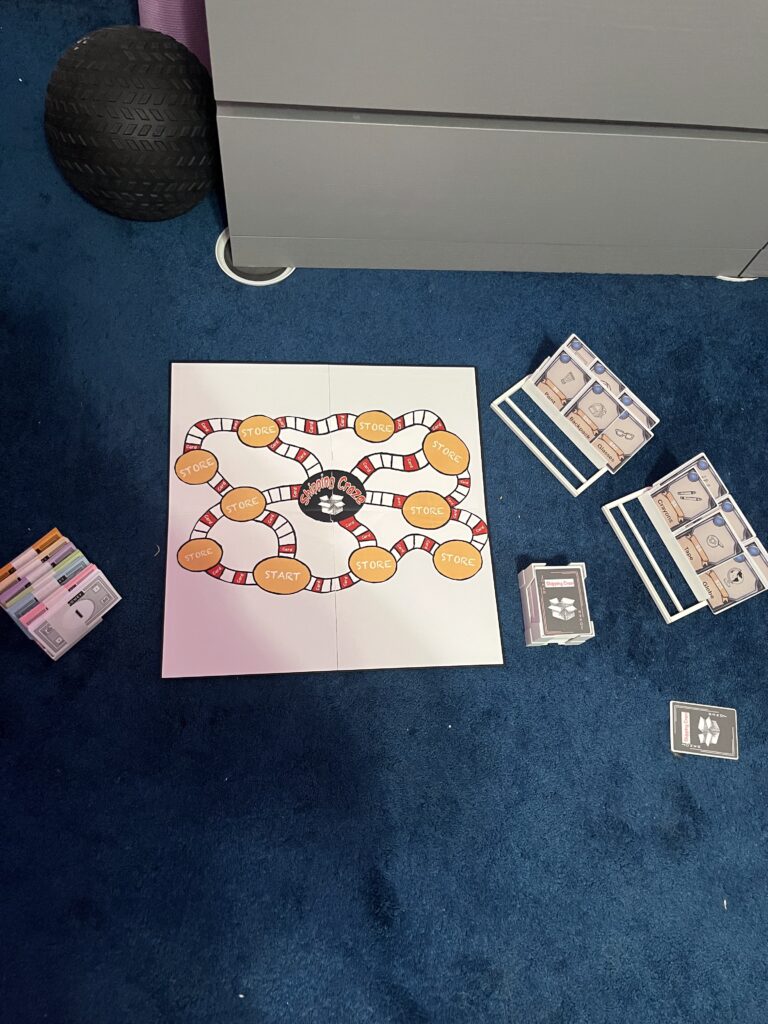
Board:
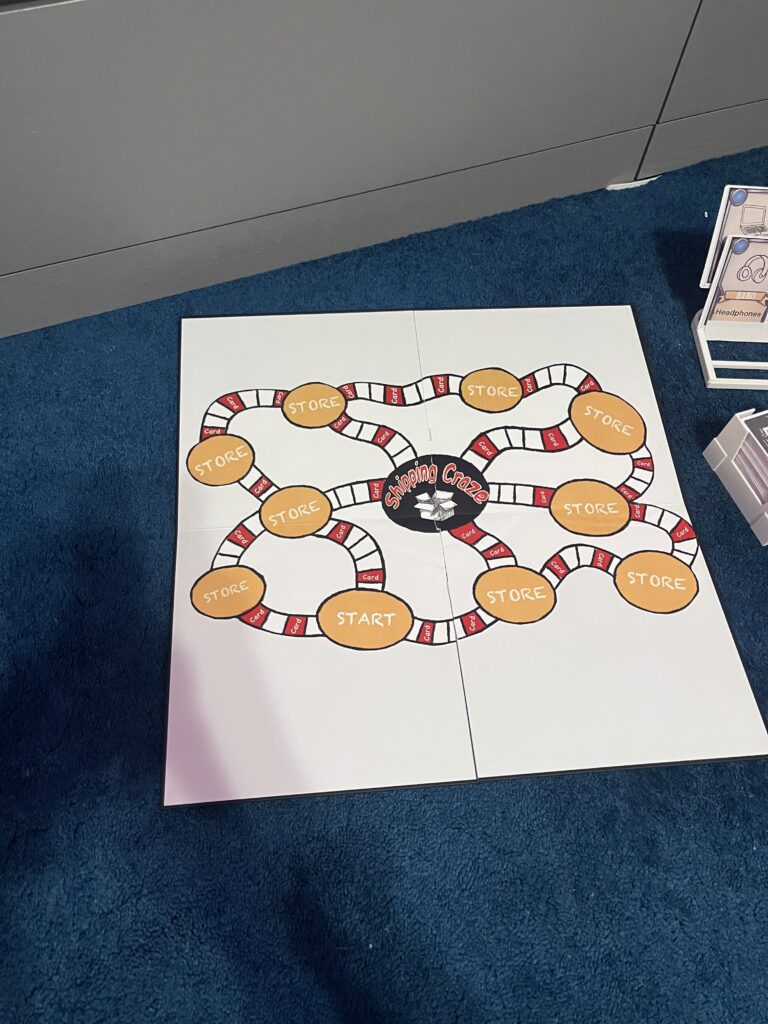
Card Holder:
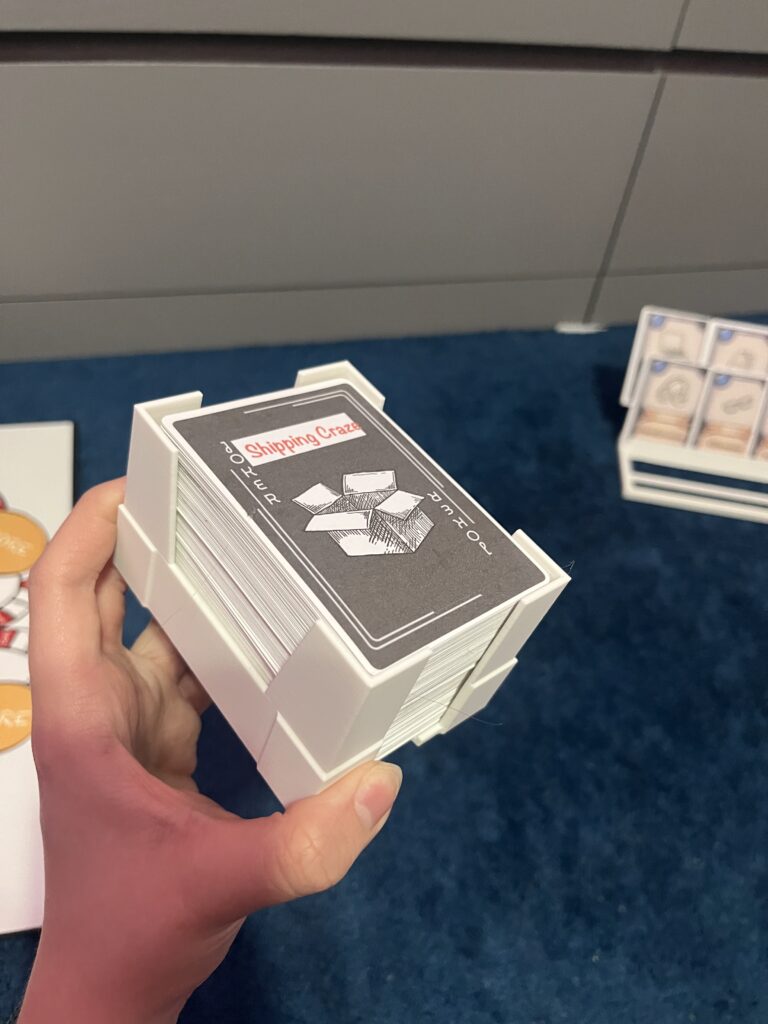
Store Card Holder:
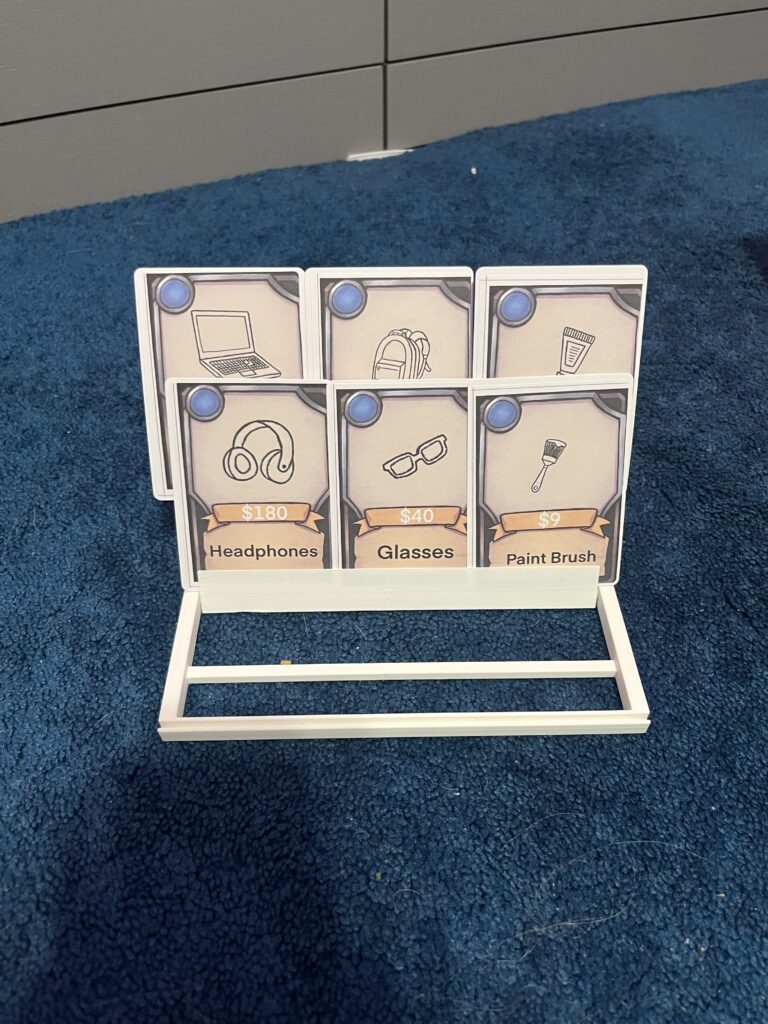
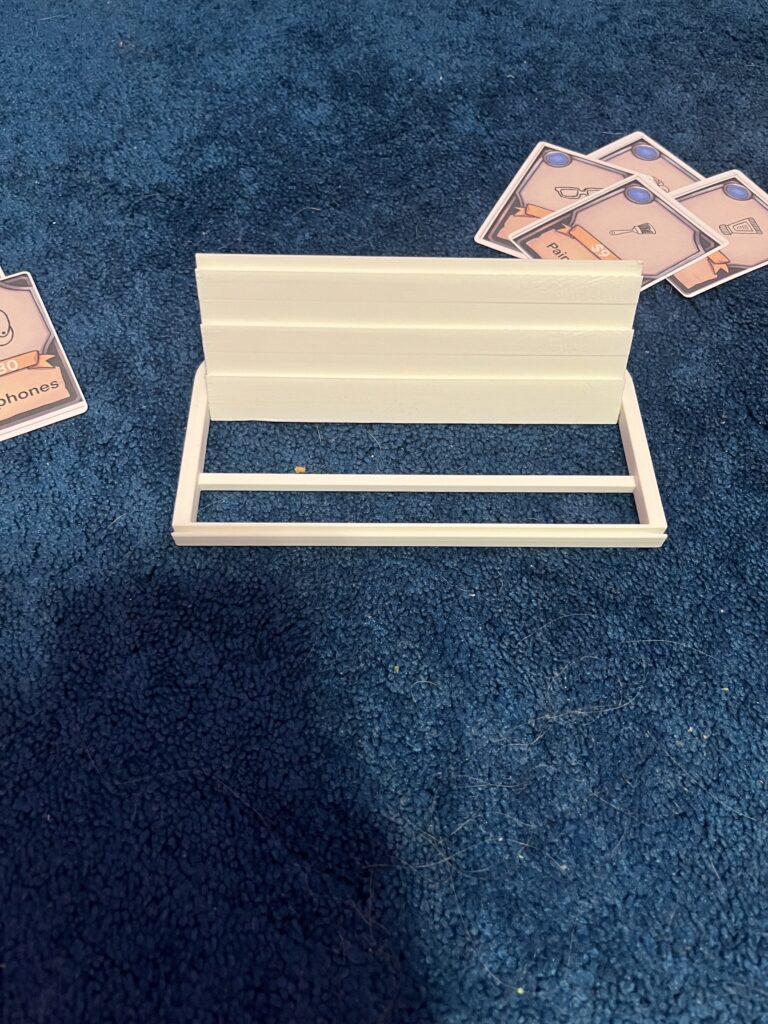
Money Holder:
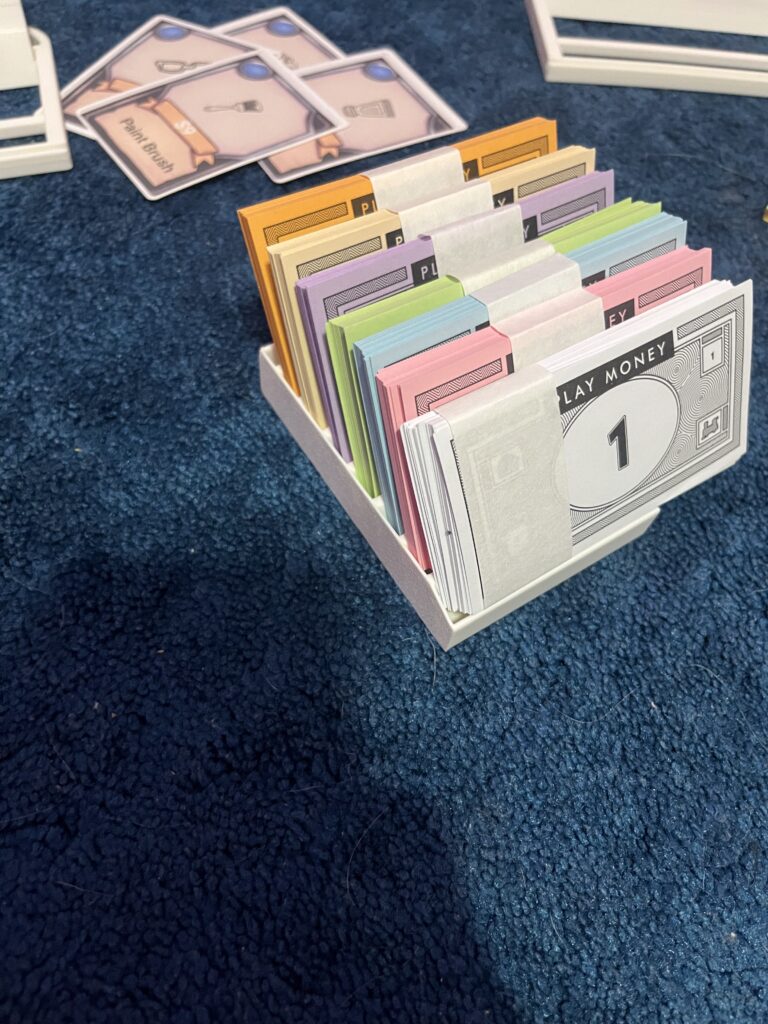
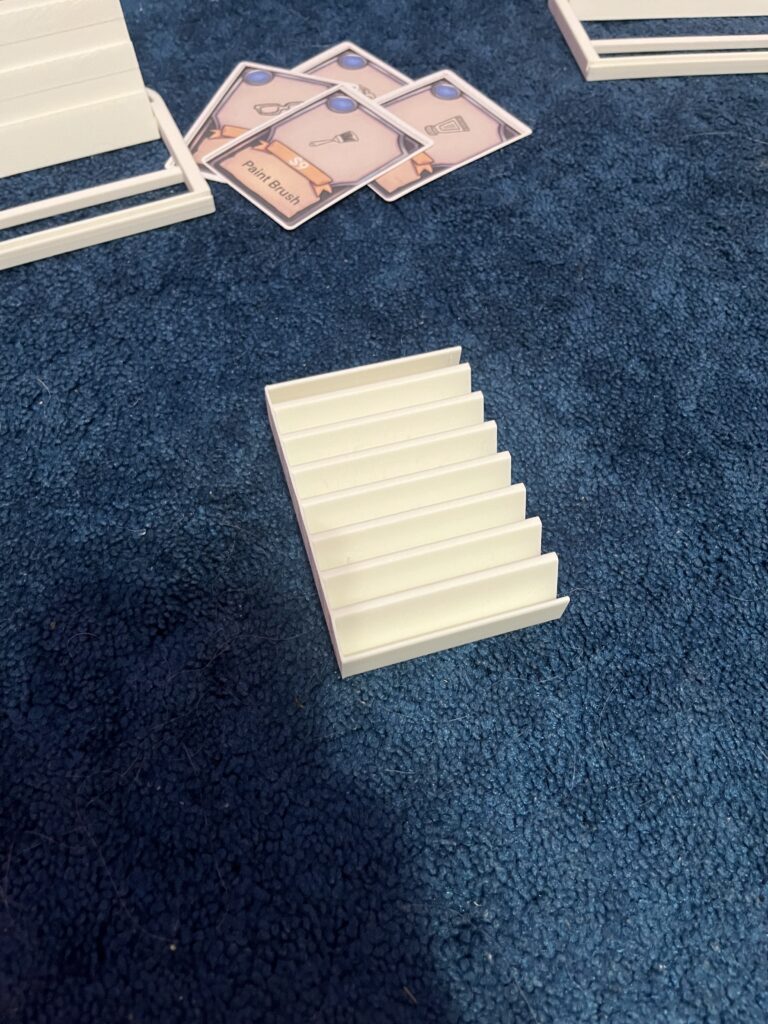
Product Cards
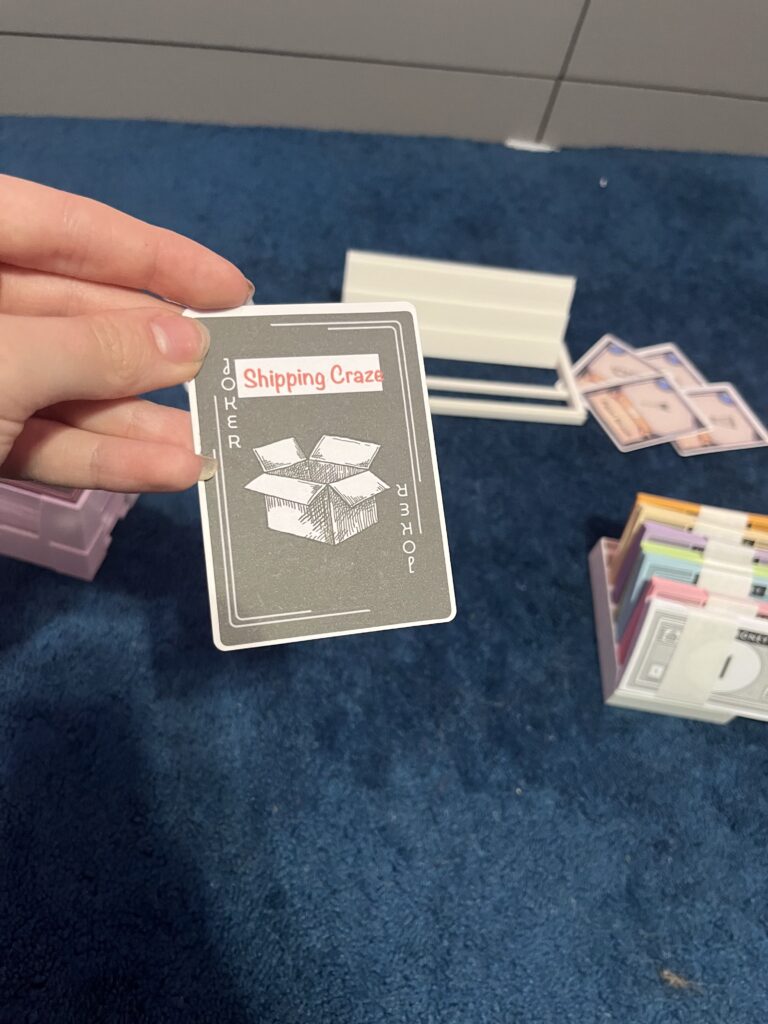
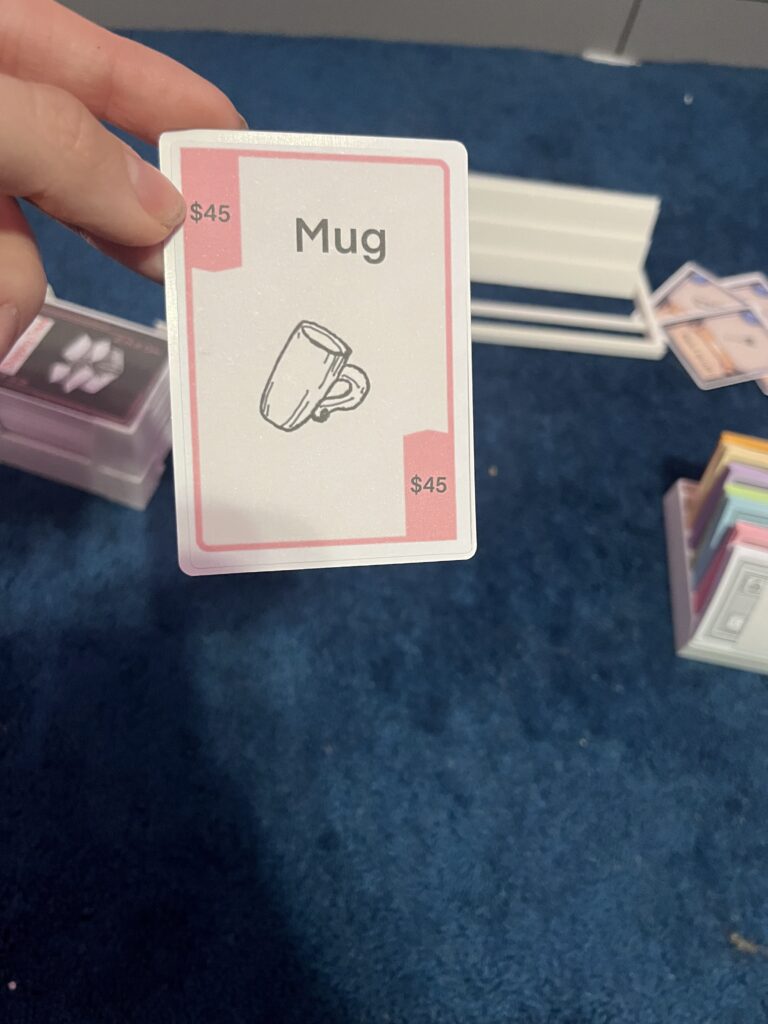
Store Cards:
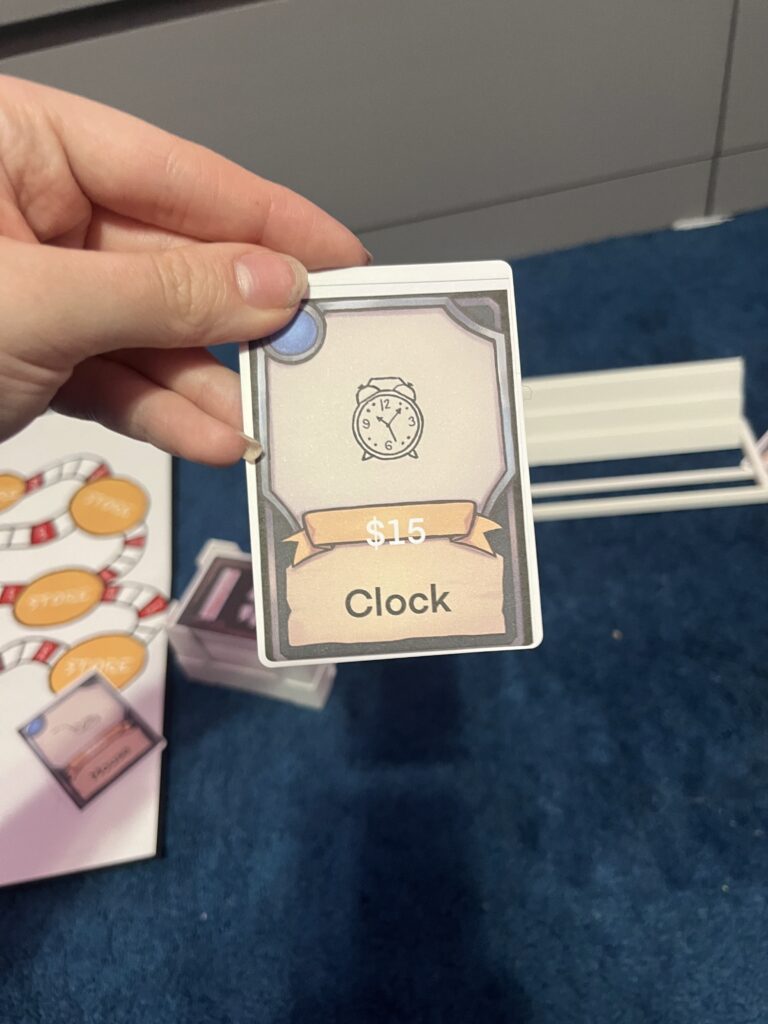

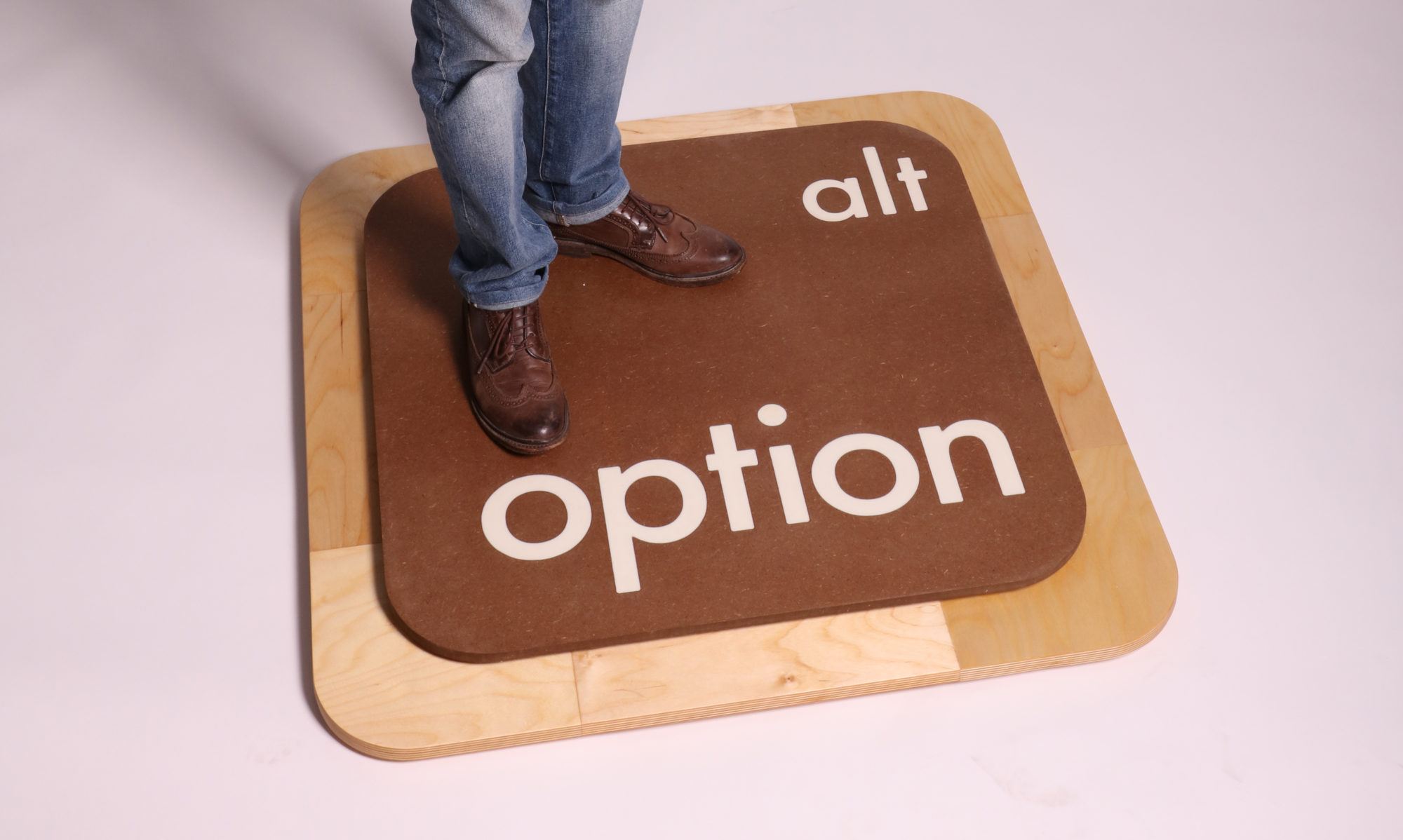
design courses, syllabi, schedules, resources and policies
So as many of you may know I was preparing a mobile game for the final. Howver due to losing some of my final during the power outage and the remaining of it not working after the power outage. Given the time that I had to start over, I decided that I was going to put a hold on my mobile game for now, and execute a final board game version of the original “Shipping Craze” game. This was just a lot easier for time and sanity sake. However I still wanted to document the mobile game.
I am not gonna go over the whole game documentation because some of it is the same as my last game documentation
This game bring players the enjoyment of the opening package sensation and buying products that they normally wouldn’t buy, without spending their own money. The game is designed that players tap on the box as it comes down the conveyor belt, and they are then rewarded an amount of money that they can later spend at the store for items of their choosing.
Shipping Craze is centered around the thrill of unboxing and impulse shopping without real-world consequences. Players tap on packages that travel down a conveyor belt to “open” them and receive in-game currency. This money can then be used to “purchase” a variety of quirky, fun, or aspirational products in a virtual store.
Short-Term:
Long-Term:
Victory Condition:
(I will uplaod Pictures of those I can)
Since it’s a digital mobile game:
The rule book is the same as the original one, I never made the mobile modifications.
These would be some changes:
Welcome to Shipping Craze!
Objective:
Tap boxes as they arrive to earn money. Spend your cash on fun virtual products and complete your collection.
How to Play:
Tips:
The mobile game was never fully play tested. However, i had many issues while developinng the game, it was a very large learning curve and there were may things that took me a long time to understand. For example it took me forver to get a working conveyor belt – that used to work prior to my files getting all messed up but no longer works anymore.
I learned so much from this process:
For the Podcast, I did it on the game ” Gone Home”. Gone Home is a first-person exploration game developed by The Fullbright Company. Set in 1995, you play as Katie Greenbriar, a young woman returning home after a year abroad. When she arrives at her family’s new house in Oregon, she finds it empty and eerily quiet. As Katie, you explore the house to uncover what happened in her absence.
The story unfolds through detailed environmental storytelling—letters, notes, cassette tapes, and personal objects scattered throughout the house. Central to the narrative is Katie’s younger sister, Sam, whose coming-of-age journey, including her struggles with identity, family acceptance, and a romantic relationship, is revealed piece by piece.
Gone Home is often described as a “walking simulator,” with no combat or puzzles—just exploration and emotional discovery. Its strength lies in how it tells a deeply personal and relatable story through atmosphere, subtlety, and a strong sense of time and place.
It will not let me upload my pocast to the actual website because the file is too large. I will try to find a way to add the video!
I recently caved and bought an Xbox, when I haven’t played video games since I was very little. So it has been a bit of a learning curve to say the least. Here are some reviews of the games that I been playing.
Shipping Craze is a fast-paced tabletop game where 4-6 players take on the roles of savvy merchants, racing to gather products, manage funds, and build the highest-value “house” by purchasing items from a shared store. Players roll dice, land on spaces to collect money, and make strategic purchases to build their collections. The goal is to be the merchant with the most valuable house when all store items are sold or no one can afford more products.
This game is perfect for players aged 12 and up who enjoy strategy, competition, and a bit of luck.
Game Design Document
Core Concept: The game is centered around the theme of product collection and strategic purchases. Players must manage their money effectively and plan their acquisitions carefully to maximize the value of their personal "house" before time runs out or the store empties.
Message/Purpose: The purpose of Shipping Craze is to engage players in a competitive environment where they must balance risk and reward, manage resources (money), and make strategic decisions. The game challenges players to think ahead and outsmart their opponents to accumulate the most valuable set of products.
Rules and Mechanics:
Dice Rolling: Determines movement on the board, creating an element of luck.
Product Cards: Represent money earned, creating a balance between luck (drawing cards) and strategy (spending money wisely).
Store Items: A shared resource that players can purchase from, encouraging competitive decision-making.
Bankruptcy: Forces players to rethink their strategies when they run out of money.
Double Rolls: Adds a layer of excitement and risk, providing an extra turn for lucky players but also the risk of losing a turn after three consecutive doubles.
The design process of Shipping Craze began with the core mechanic of collecting products to build a valuable house. The initial iteration was quite simple, with players moving around the board and collecting items, but it lacked strategic depth. Early testing revealed that players often rushed to buy whatever they could, resulting in an unsatisfying game that didn’t reward long-term planning.
Key Decisions Made:
I introduced the concept of a "house" where players store purchased products to help them track their progress and give them a visual goal to work toward.
A store with limited products was added to introduce competition and prevent players from hoarding resources without challenge.
I added the rule for bankruptcy to add tension and prevent players from simply buying low-value items repeatedly.
The Double Roll rule was implemented to keep the game dynamic and prevent players from becoming complacent.
Game Mechanics
The game is centered around three key mechanics:
Dice Rolling: Players roll two dice on each turn to determine how far they move on the board. Rolling doubles gives players an extra turn, but rolling three doubles in a row results in forfeiting a turn.
Collecting Products: Players land on spaces to draw Product Cards, which provide them with money tokens. The money earned helps players purchase store products.
Purchasing Products: The products in the store are limited, and players must carefully choose which items to buy with their accumulated money. Items vary in price and value, requiring players to think strategically about when and what to purchase.
Players aim to build the highest-value house by purchasing items from the store. The value of each product is represented by the money it earns when collected. At the end of the game (when the store is out of products or players can no longer afford to buy), the player with the most valuable house wins. To achieve this, players must:
Collect money by drawing product cards.
Strategically purchase valuable items from the store.
Monitor the other players’ progress to prevent them from getting ahead.
Gameplay Sequence
The game unfolds in a series of turns:
Roll the Dice: The player rolls two dice to determine movement.
Land on a Space: The player lands on a space that might allow them to collect a product card or purchase from the store.
Product Collection: If a player lands on a "Pick up a Product" space, they draw a Product Card and receive money based on the card’s value.
Purchasing: Players may then spend their collected money to buy products from the store.
End Turn: Once purchases are made, or the player opts not to buy anything, their turn ends, and the next player takes their turn.
The Shipping Craze board includes spaces for dice rolling, product collection, and the store where players can buy items. The board is divided into different segments, such as "Start" and "Product Spaces," where players can land to collect products.
Components:
Dice (2): To determine movement.
Product Cards (200): Cards representing products and the money earned when collected.
Store Items (150): Physical items for sale in the store, each with a price tag.
Money: Represent the cash players use to make purchases.
Player Markers: Used to track the player's position on the board.
Product Boxes (3): Store items are kept here for players to purchase.
The store is the focal point of the game’s strategy, influencing player decisions as they navigate the board and plan purchases.
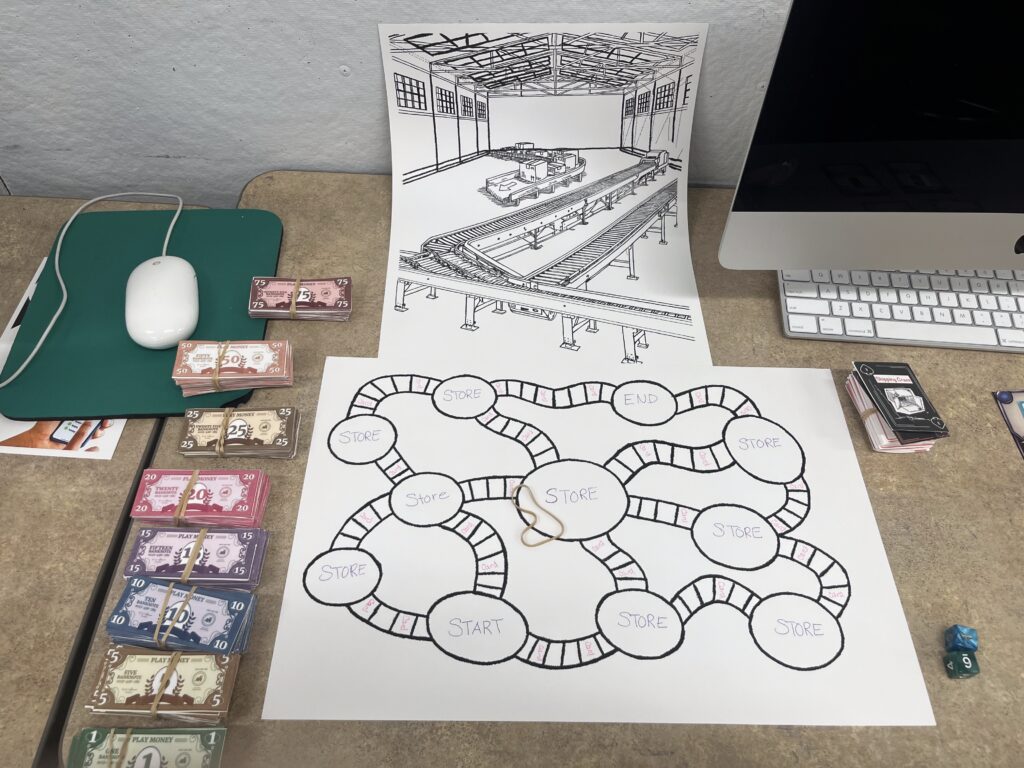
Board/Set up

Store Items


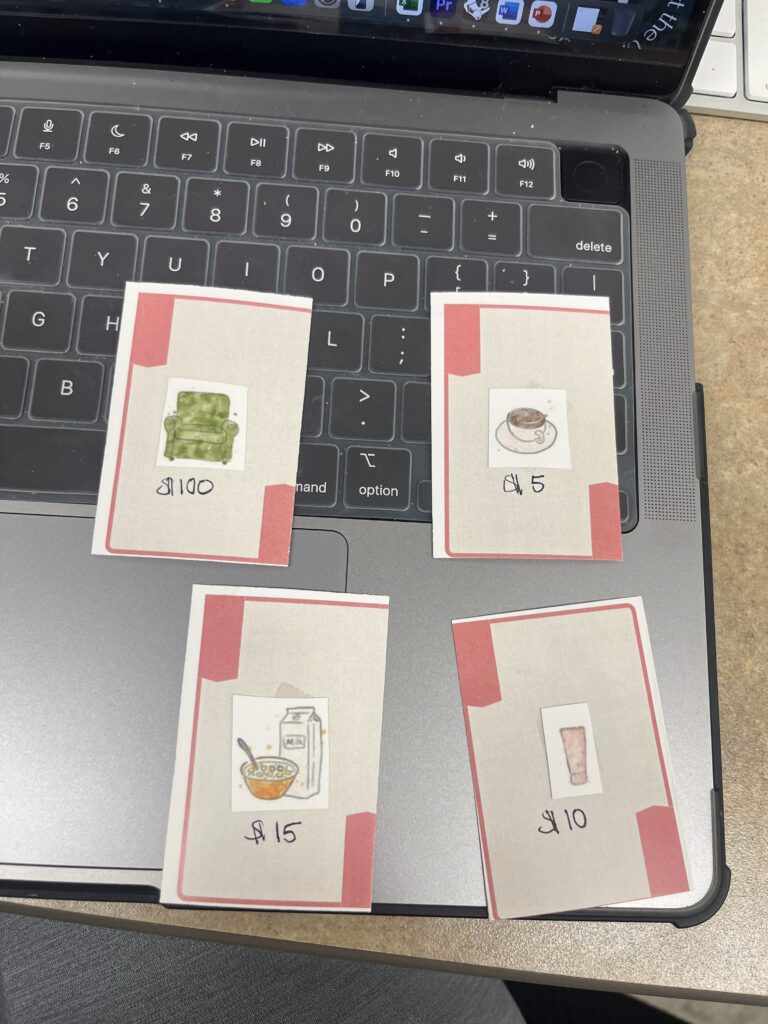
Playtesting Notes
Player Questions:
Players were curious about potential player-to-player interactions, such as trading or sabotaging, which aren't currently part of the game. Others asked what happens when the Product Deck or store items run out, leading to minor confusion about the late-game flow.
Learning Curve:
Most players learned the game very quickly—within about 5 minutes of explanation. While the core mechanics (rolling, collecting, buying) were easily grasped, the strategic timing of purchases and resource management took a bit longer to click.
Player Interactions:
Interaction between players was mostly indirect—centered on competition for store items and comparing purchases. Some players added fun by joking about each other's earnings and choices. However, deeper interactions like blocking, stealing, or trading were missing, which some found limiting.
Confusion Points:
Players were unclear on when they could access the store. Some believed they could buy items as soon as they had the funds, not realizing they needed to land on a store space. Others weren’t sure what to do when they had no money or if the store was out of items.
Player Enjoyment:
Players really enjoyed collecting products, building their “house,” and anticipating dice rolls. Big moments—like pulling a high-value card or rolling doubles—sparked a lot of excitement.
Frustrations:
Players felt frustrated when stuck with low-value items or when they couldn’t make purchases due to lack of money. The bankruptcy rule, while useful in adding tension, could feel punishing and left some players with little to do. Some also struggled when the store ran out of products.
Takeaways:
Although the game wasn’t designed to teach lessons explicitly, players came to understand that hoarding money for expensive items isn’t always the best strategy. Many realized that buying multiple smaller items could be just as effective, aligning with the game’s intended message about balancing price and value.
What I Learned
The biggest takeaway from developing Shipping Craze is the importance of balancing strategy and player interaction. While players enjoyed collecting and competing for resources, they wanted more ways to interact beyond just racing for items. The excitement of dice rolls and product draws was strong, but the independent nature of play could sometimes make it feel solitary.
Addressing Feedback
To address confusion and enhance interaction:
I plan to redesign the store layout to make it more visible and accessible for all players.
I'll add a new "Chance Card" mechanic to bring more dynamic events into play. These cards could let players:
Steal items from other players
Take free products from the store
Freeze an opponent’s turn
Earn surprise bonuses
This addition will introduce risk-reward dynamics and promote more player engagement.
What I will Do Differently
In the next iteration, I will:
Refine rules around store access to make them clearer.
Introduce more layered strategy, like card combos or item synergies.
Possibly explore team modes or multiplayer challenges to enhance social gameplay.
While the game was successful in encouraging smart spending and value assessment, I want future versions to offer deeper player interaction and less downtime, especially when players fall behind.
Sustainable City Builder is a strategy board game where players take on the role of city planners tasked with creating a thriving, eco-friendly urban environment. Players must manage resources like money, energy, and waste while balancing environmental challenges, including climate events and population growth. The game encourages sustainable practices such as building renewable energy sources, improving public transportation, and increasing green spaces. It’s designed for 2-4 players, ages 12 and up, who enjoy strategic planning, resource management, and tackling environmental issues in a fun, competitive way.
This should describe our game, what do players do and who is it for?
Game Design Document (GDD)
Core Concepts:
Objective: Players aim to build the most sustainable city by managing resources effectively and overcoming environmental challenges. The game ends after 10 rounds or when a player reaches a population threshold.
Message/Purpose: The game aims to raise awareness about sustainability and environmental issues while providing a fun, strategic gameplay experience.
Rules: Each player builds their city by constructing buildings (residential, industrial, commercial) and managing resources like money, energy, and waste. Players face climate events and challenges that force them to adapt their strategies.
Mechanics:
Resource Management: Players must track money, energy, population, and waste throughout the game.
City Construction: Players build and upgrade buildings, focusing on renewable energy, green spaces, and waste management.
Climate Events: Random events like droughts, pollution spikes, and heatwaves affect the players' cities.
Challenge Tokens: Players face challenges like population growth or economic crises that impact their resource management.
I iterated on Sustainable City Builder in several ways:
Initial Concept: I started with a broad city-building game concept. The first draft included basic resource management and construction mechanics but lacked a cohesive theme or focus.
Early Playtesting: During my first playtests, players found the resource management too overwhelming, leading to overly complex setups. I simplified the number of resources tracked (e.g., removing excessive types of tokens) and introduced a more intuitive system for balancing energy, waste, and money.
Introducing Climate Events: One of the major improvements I made was adding climate event cards, which introduced a level of unpredictability and forced players to adapt quickly. This helped maintain excitement and challenge throughout the game.
Victory Point System: Initially, players simply tracked their achievements. Later, I added victory points for sustainable practices (like reducing carbon footprints or increasing green spaces) to provide more meaningful goals and competition.
Game Mechanics
Key game mechanics include:
Resource Management: Players must manage their money, energy, population, and waste levels. Mismanagement can lead to penalties during climate events.
Example: A player who builds too many factories without adequate waste management will face penalties when a pollution spike occurs.
Building and Upgrading: Players choose which types of buildings to construct, such as residential areas, renewable energy plants, or transportation hubs. Each building has a cost and a benefit.
Example: Solar panels provide energy but cost money to build. The player must decide whether the long-term benefits outweigh the immediate cost.
Climate Events: At the end of each round, players draw a climate event card that affects all players. These events can either help or hinder the cities.
Example: A heatwave increases energy consumption, so players with a renewable energy grid are better equipped to handle it.
Challenge Tokens: Random events or thresholds in a player's city trigger specific challenges, such as population growth, economic downturns, or environmental disasters.
Player Goals
The goal of Sustainable City Builder is for players to build the most sustainable city by the end of 10 rounds or when a population threshold is reached. Players win by:
Accumulating Victory Points (VP) through sustainable actions such as building renewable energy, expanding green spaces, and managing waste.
Managing their city’s resources effectively, ensuring the balance between energy consumption, waste, and population growth.
Overcoming challenges and navigating climate events to avoid penalties and maintain the growth of their city.
End Game & Winning:
The game ends after 10 rounds or when a player reaches a certain population threshold (e.g., 100,000 citizens).
At the end of the game, players tally their Victory Points (VP) based on their sustainable actions:
Energy Sustainability: Using renewable energy vs. non-renewable sources.
Green Spaces: Number and quality of parks and green areas.
Waste Management: How efficiently waste was handled.
Public Transportation: Efficiency and coverage of transit systems.
Bonus Points: For achieving milestones like zero carbon emissions or 50% renewable energy.
The player with the most Victory Points wins the game!
I really didn't take many pictures of this process either.
Game Setup:
Board Setup: Place the game board in the center of the table. Shuffle the City Cards and Climate Event Cards.
Player Setup: Each player receives a player board, starting resources (money, energy, population, waste), and a set of City Cards.
Draw Challenge Tokens: At the beginning of the game, draw a few challenge tokens that will affect players as they progress through the game.
Gameplay Sequence
Planning Phase: Players choose cards to build or upgrade structures in their city. Strategic decisions on what to prioritize (e.g., public transport, renewable energy) are made during this phase.
Building Phase: Players use their resources (money, energy, etc.) to construct buildings, such as residential areas, parks, or recycling centers, to improve their city’s sustainability.
Climate & Challenge Phase: Players draw a climate event card, which affects all players. They also draw challenge tokens, which may create additional problems or opportunities based on the state of their cities.

Game Board:
The game board represents a city with several zones and areas for development. It’s laid out on a grid where players can build their sustainable infrastructure.
Zones:
Victory Points Track: A continuous track on the edge of the board that records the players’ sustainability achievements, such as reducing carbon footprint, improving public transportation, and building green spaces.

2. City Cards:
Cards that represent various types of buildings and infrastructure, like solar panels, wind turbines, parks, recycling centers, and metro stations. Each card has a cost to build and offers benefits (e.g., energy production, green space, waste reduction).

Resource Tokens:
Represent the essential resources used for building and maintaining the city:
Waste Tokens: Track the amount of waste generated, which needs to be managed.
Money Tokens: Used to construct buildings and pay for upkeep.
Energy Tokens: Represent the energy produced and consumed by the city.
Population Tokens: Represent the number of residents in the city.

Population Tokens

Energy Tokens

Money Tokens

Money Tokens

4. Climate Event Cards:
Random events that add unpredictability and require players to adapt. These events can either benefit or hinder players’ progress, and they can affect all players.
Pollution Spikes: Increase waste and impact public health.
Types of Events:
Storms: Reduce energy production or waste management efficiency.
Droughts: Affect water resources and agricultural production.
Heatwaves: Increase energy consumption and waste.

5. Challenge Tokens:
Tokens that represent various challenges faced by players during the game. These can be drawn at the beginning of a round or triggered by specific conditions.
Environmental Damage: Pollution or loss of biodiversity affects happiness or requires immediate action.
Types of Challenges:
Population Growth: Requires more resources to support a growing population.
Economic Crisis: Players must reduce their spending or energy production temporarily.

6. Player Boards:
Each player has their own board to track progress and resources. The player board includes:
Turn Summary: A quick reference to track what has been achieved at the end of each round.
Resource Tracker: Displays money, energy, population, and waste levels.
Sustainability Milestones: Tracks goals such as reducing carbon footprints, improving public transportation, and adding green spaces.
Energy & Waste Consumption: Tracks energy production vs. consumption and waste generation vs. management.
Victory Points Tracker: Shows the player’s progress in terms of sustainability goals.

Victory Point Tokens:
Players earn Victory Points (VP) based on their sustainable actions, such as:
Reducing their carbon footprint.
Increasing green space.
Successfully managing waste.
Improving public transportation.
Reaching sustainability milestones.
Playtest Session 1:
Feedback:
Positive:
Players enjoyed the strategic aspects of building green spaces and investing in renewable energy. The sense of long-term planning and the satisfaction of seeing their city grow sustainably was very engaging. They also appreciated how public transportation reduced traffic congestion and emissions.
Challenge:
Players were unsure about how to handle Climate Events. They found it difficult to anticipate how these random events would impact their city, leading to some frustration when their well-laid plans were disrupted.
Challenge Tokens caused confusion, especially with dice rolls and thresholds. Players weren’t clear on when these would be triggered or how they interacted with the resources on their player boards.
Adjustments:
Quick Reference Guide:
Introduced a Climate Events guide explaining how the Climate Event Cards work and their potential effects. This also included examples of Challenge Tokens and how dice rolls can trigger challenges, with clear thresholds for each resource type.
Victory Points Tracker:
Added a more visible Victory Points tracker on the board to clarify how players earn points. Now, players can easily see how their investments in green spaces, renewable energy, and public transportation contribute to their score.
Clarified Challenge Token Rules:
Simplified the explanation of Challenge Tokens by introducing a step-by-step visual guide for triggering and resolving them based on dice rolls and resource thresholds.
Playtest Session 2:
Feedback:
Positive:
Players appreciated the variety in Challenge Tokens, as they made the game feel dynamic and kept them on their toes. The Victory Points system, once clarified, provided a satisfying sense of progression. Players particularly enjoyed the moment-to-moment decisions of balancing energy production, waste management, and population growth.
Challenge:
Some players felt overwhelmed by the need to track multiple resources at once, especially in the early game. They struggled with balancing money, energy, population, and waste while also trying to grow their city sustainably. This left some players feeling like they couldn’t get a solid grasp on where to focus their efforts.
Adjustments:
Early Game Bonus:
Introduced an early-game bonus in the form of additional starting resources (e.g., 1 extra energy or money) to help players get a smoother start and allow them to better balance their resources as they progress.
Resource Balancing Tutorial Phase:
Added a tutorial phase at the beginning of the game where players could take a couple of turns to practice managing resources without worrying about Challenge Tokens or Climate Events. This helped new players understand how to balance their resources and made the early game feel less overwhelming.
Additional Clarity for Resource Tracker:
Made the resource tracker clearer by adding resource icons next to the amounts on the board, so players could more easily keep track of their resources and see where they needed to adjust.
Overall Observations:
Strengths:
The game encourages long-term strategic planning with a focus on sustainability.
Players enjoyed the mix of competitive and cooperative elements, especially when discussing strategies to tackle challenges.
The Victory Points system was well-received once players understood it, and the satisfaction of balancing sustainability elements was high.
Areas for Improvement:
The early game felt too overwhelming due to resource balancing. The amount of management required, particularly in tracking resources and planning for challenges, could be simplified for new players.
Climate Events and Challenge Tokens were still a bit too disruptive and unpredictable for some players, especially when they caused unexpected setbacks.
Next Steps:
Continue refining resource management to ensure players can balance them more easily in the early stages. Explore introducing resource milestones that give players clearer objectives on what to prioritize.
Further clarify Climate Event rules and Challenge Token triggers. Consider streamlining these mechanics to reduce randomness and make the game feel more controllable, even during these phases.
Expand the tutorial phase to give players a better introduction to how they can build a sustainable city. This could include a goal-oriented setup where players focus on specific objectives (like a goal to reduce waste or expand green spaces).
Test additional balancing mechanics for players who may be falling behind, ensuring that all players feel like they have a chance to win up to the last round. Perhaps add an "environmental recovery" system that rewards players who fall behind in sustainability.
Game Reflections:
What I Learned:
Balancing Complexity: Early feedback showed that players felt overwhelmed by too many mechanics. I learned that while it's important to have depth, the game needs to be simple enough for players to grasp quickly. Introducing mechanics gradually would help players ease into the game.
Resource Management: Managing resources (money, energy, waste) was tricky for some players, especially in the early rounds. I realized that a clearer starting phase or tutorial could help players focus on balancing these resources from the get-go.
Climate Events: While the unpredictability of climate events created tension, it sometimes disrupted players' plans too much. A better balance would give players more control and preparation options.
Victory Points: Players had difficulty understanding how different actions earned Victory Points. I learned that the connection between actions and rewards needs to be more obvious to guide strategic decisions.
What I’d Do Differently:
Simplify Resource Management: I'd reduce the number of resources players need to manage or make the tracking system more intuitive to prevent confusion early on.
Balance Climate Events: I’d refine the climate event system to ensure they’re challenging but not game-breaking. Giving players more ways to prepare for or deal with them would make the game feel fairer.
Clarify Victory Points: I’d make it clearer how each action contributes to earning Victory Points, possibly with a visual tracker that shows progress in each area (like energy, waste, green spaces).
Add More Interaction: I’d introduce a few cooperative elements or give players the option to form temporary alliances to make the game feel more dynamic.
Next Steps:
Refine the Climate Event System to make it challenging but not too disruptive.
Simplify Resource Management to reduce complexity early in the game.
Clarify Victory Points by improving the tracking system and the connection between actions and rewards.
Test Cooperative Elements to see if they increase player engagement.
The “Sell Me This” Challenge is a fun and fast-paced game designed to test players’ creativity and persuasive skills. Players take turns acting as the seller and the buyer, with the goal of convincing the buyer to purchase an everyday object using their best sales pitch.
Core Concepts:
"Sell Me This Challenge" is a fast-paced, social party game where players take turns acting as the seller and the buyer. The objective is to craft the most convincing sales pitch to persuade a buyer to purchase everyday objects, despite various challenges. Players must adapt to different scenarios, think quickly, and use creativity to sell the product effectively. The game tests players' persuasion skills, creativity, and ability to think on their feet.
Message/Purpose:
Core Message: The game aims to enhance communication and persuasion skills through creative thinking and adaptability. It encourages players to think on their feet and craft engaging, convincing narratives to sell everyday products in a fun and light-hearted setting.
Purpose: "Sell Me This Challenge" is a party game that provides players with an entertaining way to develop their sales and presentation abilities while engaging in a competitive and humorous environment.
Game Rules and Mechanics:
Setup:
Players decide who will be the seller and who will be the buyer. The youngest player starts as the seller, and turns alternate clockwise.
The spinner wheel determines which category the seller will pick their object from (Around the House, In the Classroom, Activities, Clothing).
Gameplay:
Seller’s Turn:
The seller spins the wheel to determine the object category and then draws an object card from that category.
The seller then draws a scenario card which introduces a challenge (e.g., a defect, a limitation, or a unique sales situation) that the seller must work around.
The seller has 2 minutes (or 1 minute for a faster pace) to make their pitch, trying to persuade the buyer(s) to purchase the item.
The seller can use any approach: emphasizing benefits, creative uses, humor, or exaggeration.
Buyer’s Turn:
Buyers decide whether they would purchase the item by placing a “Buy” or “Pass” card face down on the table.
The seller reveals the cards after all buyers have voted. If the majority of buyers vote "Buy", the seller keeps the object card. If the majority votes "Pass", the object card is returned to the deck.
After each round, roles are reversed, and a new seller is chosen.
Victory Conditions:
The game continues until one player collects 7 object cards.
Points are awarded based on the difficulty or value of the object cards, with easier objects worth 1 point and more challenging ones worth up to 3 points.
The player with the most points at the end of the game wins, not just the first player to 7 cards.
Special Spaces (on the Game spinner):
Gray or Black Spaces: Players must follow the instructions, like losing a card or skipping a turn.
Steal a Card: Allows a player to take an object card from another player.
Game Variations:
Mystery Box Challenge: The seller cannot see the object and must sell it based on a brief description.
Time Pressure: Shorten the sales pitch time (1 minute or 30 seconds) for a more intense challenge.
Theme Pitches: The seller must tailor the pitch to a specific audience (e.g., sell the object to a billionaire or a child).
Pitch Continuation: The buyer can ask questions during the pitch, testing how well the seller can adapt.
Target Audience:
"Sell Me This Challenge" is designed for players who enjoy social interaction, humor, and creativity. It’s perfect for parties, family gatherings, or team-building exercises, with a focus on players aged 12 and up. It’s ideal for 2 or more players but can also be played in teams.
Design Notes:
The game should encourage players to think outside the box, using their imagination to create entertaining and persuasive pitches.
The Scenario Cards introduce a layer of challenge that keeps the game unpredictable, requiring players to adapt their strategies on the fly.
Fun and humor are key elements of the game, allowing players to have a good time even when things get a bit over-the-top.
Initial Challenges and Decisions
Challenge 1: Slow Game Play
Issue: The game felt too slow because players took too long with their pitches.
Solution: I added timers—a 1-minute timer for fast rounds and a 2-minute timer for regular rounds. This sped up gameplay and kept things exciting.
Challenge 2: Repetitive Gameplay
Issue: Players were running out of ideas, and pitches started to feel repetitive.
Solution: I introduced Scenario Cards that added challenges to the sales pitch (e.g., a defective product), making the game more creative. I also added a wheel to randomly choose product categories, keeping things fresh.
Challenge 3: Different Skill Levels
Issue: Some players struggled with the game because they had different sales experience levels.
Solution: I made the game team-friendly so experienced players could help beginners. I also focused on fun feedback, where buyers could judge based on creativity and humor, not just persuasion skills.
Challenge 4: Unbalanced Scoring
Issue: Some products were too easy to sell, others too hard, which felt unfair.
Solution: I added a point system, where harder-to-sell items were worth more points. This kept things competitive, giving players a reason to take on more challenging products.
Challenge 5: Lack of Replay Value
Issue: After several rounds, the game started to feel predictable.
Solution: I introduced game variations, like the Mystery Box Challenge (where sellers can’t see the item) and Themed Pitches (e.g., selling to a celebrity). These kept the game interesting each time you played.
Challenge 6: Confusing Rules
Issue: The original rulebook was too complicated.
Solution: I simplified the rules and added a quick-start guide so players could jump right into the game without reading too much.
Final Results:
The game is now fast-paced, fun, and offers endless variety. With the timers, Scenario Cards, and game variations, players stay engaged, and every round feels different. The point system balances competition, and team play helps players of all skill levels enjoy the game. The changes I made improved the overall experience and made the game more fun and accessible for everyone.
Game Mechanics of "Sell Me This Challenge"
1. Roles: Seller & Buyer
Seller: The player who pitches a product to the buyer, trying to convince them to make a purchase.
Buyer: The player who listens to the pitch and decides whether to buy the product or not.
Gameplay Flow:
The seller and buyer roles alternate after each round. The game begins with the youngest player being the seller.
2. Spinning the Wheel
Purpose: The wheel determines which category the seller will draw an object card from.
Categories: Around the House, In the Classroom, Activities, Clothing
Diagram:
Imagine a spinner divided into 4 sections: one for each category. The seller spins the wheel to land on a category. Each category corresponds to a different type of object the seller will try to sell.
3. Drawing an Object Card
After spinning the wheel, the seller draws an Object Card from the deck of the selected category. Each card describes a typical item that could be sold.
Example Object Cards:
Around the House: Vacuum cleaner, blender, etc.
In the Classroom: Whiteboard, desk, etc.
Activities: Tennis racket, kayak, etc.
Clothing: T-shirt, jacket, etc.
4. Scenario Card
After selecting an object, the seller draws a Scenario Card. This card adds a challenge to the sales pitch.
Example: "The product has a defect" or "The buyer is on a very tight budget."
The seller needs to adjust their pitch based on the scenario.
5. Making the Sales Pitch
Objective: The seller has a set time (1 or 2 minutes) to pitch the product, addressing any challenges presented by the Scenario Card.
The seller must use persuasive techniques such as humor, logic, emotion, or exaggeration to make the item appealing.
6. Buyer’s Feedback
After the pitch, the buyer(s) (other players) decide whether they would buy the product or pass on it.
The buyer places either a “Buy” Card or “Pass” Card face down.
Buy: The seller successfully convinced the buyer.
Pass: The seller was not convincing enough.
Example:
Buyer Cards: Each player gets a "Buy" and "Pass" card to show their decision.
7. Scoring & Outcome
Majority Decision: If the majority of buyers choose "Buy," the seller keeps the Object Card as a successful sale.
If most buyers choose "Pass," the object is returned to the deck.
Players earn points based on the difficulty of the object, with harder-to-sell items being worth more points.
Example: An item like a vacuum cleaner might be easier to sell than a kayak, so the kayak could be worth more points.
Points System:
Around the House Cards: 5 points
In the Classroom Cards: 4 points
Activities Cards: 3 points
Clothing Cards: 2 points
8. Role Rotation
After each round, the buyer becomes the seller, and the game continues with a new pitch.
9. Winning the Game
The game ends when a player collects 7 Object Cards, but they don’t automatically win. The winner is the player with the most points based on the value of the items they've sold.
Illustrations of Key Mechanics:
Wheel Spin:
The spinner would have 4 equal sections representing the categories. After spinning, the seller draws an Object Card from the corresponding deck.
Object Card & Scenario Card:
Example: A card showing a vacuum cleaner and a scenario card stating “The vacuum has a broken hose.” The seller must convince the buyer despite the defect.
Timer for Pitches:
A 1-minute or 2-minute timer (e.g., a digital timer or hourglass) to limit the seller's pitch duration.
Feedback Cards:
Each buyer has a “Buy” or “Pass” card to vote on the pitch.
Conclusion:
The core mechanics of "Sell Me This Challenge" revolve around creative pitching, adapting to challenges, and convincing the buyer through quick thinking. Players learn to improvise, get creative with scenarios, and hone their persuasion skills—all while having fun!
Player Goals in "Sell Me This Challenge"
Main Objective:
The ultimate goal of "Sell Me This Challenge" is to collect the most points by successfully selling various items, using creative and persuasive sales pitches. Players achieve this by convincing buyers to purchase the items they are selling, despite challenges and scenarios that may arise during the pitch.
How to Achieve Victory:
Make Successful Sales:
The key to achieving victory is convincing the buyer(s) to purchase the object being sold. After each sales pitch, the buyer(s) decide if the pitch was convincing enough using “Buy” or “Pass” cards.
If the majority votes “Buy,” the seller earns the object card and earns points based on the difficulty of the item sold.
Earn Points from Sold Items:
Different items have different point values based on how difficult they are to sell:
Around the House Cards: 5 points each
In the Classroom Cards: 4 points each
Activities Cards: 3 points each
Clothing Cards: 2 points each
The more convincing and creative the pitch, the higher the chances of earning these valuable object cards.
Deal with Scenario Cards:
Each round introduces a Scenario Card that presents a challenge or limitation to the seller. Sellers need to adapt their pitch to address these challenges. For example, the object might be defective, or the buyer may have a limited budget. Overcoming these obstacles with a convincing pitch earns the player the object and points.
Continue to Sell:
Players take turns as the seller and buyer, continuing to pitch and sell items. Every successful sale brings the player closer to accumulating the required 7 Object Cards to end the game. However, collecting 7 cards is not enough to win; players must have the most points to claim victory.
How to Win the Game:
Game Ends: The game ends when a player collects 7 Object Cards.
Final Victory: The player with the most points from successful sales (determined by the difficulty of the items they sold) wins the game.
Summary of Goals:
Sell products by convincing the buyer with a persuasive pitch.
Earn points based on the difficulty of the items sold.
Adapt to challenges introduced by Scenario Cards to make creative and convincing pitches.
Be the first to collect 7 Object Cards and have the highest score based on points to win.
I really didn't take any pictures of this process while it was being played but here are the steps of the game play in detail:
1. Setup Phase:
Description: Players get ready by selecting their roles (Seller and Buyer). The game board, Spinner, and cards are set up. Each player has a set of "Buy" and "Pass" cards.
Key Visual:
Players around the game table, each holding their “Buy” and “Pass” cards.
The spinner wheel placed in the center.
A stack of Object Cards and Scenario Cards to the side of the board.
Player Action: The first player spins the wheel to determine the category for their pitch (e.g., "Around the House," "Clothing," etc.). The seller then draws a Scenario Card.
2. Spinner and Card Drawing:
Description: The player spins the wheel to determine which category they will sell from. After spinning, they draw an Object Card from that category and a Scenario Card that presents a challenge they must incorporate into their sales pitch.
Key Visual:
A spin of the wheel showing categories like "Around the House," "Clothing," etc.
Object Card in hand, with an image of the object (e.g., a broken toaster or a fancy jacket).
A Scenario Card that gives them an obstacle, such as "This toaster has a broken lever," or "This jacket is too large for anyone under 6 feet."
Player Action: The seller reads the card aloud and prepares their pitch, knowing they need to incorporate the challenge into their strategy.
3. The Pitching Phase:
Description: The seller has 1 or 2 minutes to persuade the buyer to "Buy" the item, despite its flaws or challenges. Players use creativity, humor, or logic to present their case.
Key Visual:
A timer on the table, showing 1 minute for a fast-paced pitch or 2 minutes for a standard one.
Seller in action, talking animatedly and possibly holding the object (or miming it).
The buyer listening and reacting, possibly with humorous or exaggerated expressions.
Player Action: The seller uses the time to convince the buyer, while the buyer listens, possibly asking questions or making comments that challenge the seller’s pitch.
4. The Buyer’s Feedback:
Description: After the pitch, the buyer(s) decide whether they are convinced to "Buy" or "Pass" on the item. The seller then flips their feedback cards to see the results.
Key Visual:
Feedback cards in hand (one showing “Buy,” the other showing “Pass”).
A spread of feedback cards on the table, with some players eagerly awaiting the verdict.
Sellers looking anxiously at the results.
Player Action: The buyers reveal their votes, and if the majority vote is “Buy,” the seller keeps the object card. If “Pass,” the card is returned to the deck.
5. Scoring and Rotating Roles:
Description: After each round, players track whether the pitch was successful. The next round begins with new roles, and the spinner determines a new category.
Key Visual:
Object cards collected by the successful seller, stacked on their side of the table.
The spinner again being spun for the next round.
Players swapping roles, with the buyer becoming the seller.
Player Action: The game continues as players rotate between selling and buying, accumulating points for successful pitches.
6. Endgame and Victory:
Description: The game ends when one player collects 7 object cards or when a predetermined number of rounds have been completed. The player with the most successful sales wins.
Key Visual:
A player with 7 object cards, their victory points clearly displayed.
Players celebrating or playfully arguing about who had the best pitch.
Player Action: The final round is completed, and the player with the highest total points (for successful pitches) is declared the winner.

Description: The game board for “Sell Me This Challenge” would likely be designed with a central playing area for object cards, a spinning wheel section, and a scoring track for victory points. The board might also have a section where players place their Buy/Pass cards for easy reference.
Key Sections:

2. Object Cards (Item Cards):
Description: Each card in the game represents an object that the seller is trying to sell, and the cards would have the following visual cues:
Influence on Gameplay:
Category Impact: Players must adjust their pitch depending on the category they land on. An item from Clothing might require a pitch focused on aesthetics, while an item from Activities might require talking about lifestyle and fun.
Strategic Decisions: The object card influences how the seller approaches their pitch. For example, an item from Around the House (worth more points) might require a more detailed or persuasive pitch.

3. Scenario Cards:
Description: Scenario Cards add a random challenge to the seller’s pitch. They might say things like:
Influence on Gameplay:
Influencing Pitch: Players might need to focus on problem-solving or turn negative aspects of an item into positives. For instance, a broken item might require a pitch focused on affordability and how the item can still serve a purpose.
Creativity and Adaptation: These cards challenge the seller to adapt their pitch and get creative. They prevent the game from becoming repetitive and push players to think on their feet.

4. Buy/Pass Cards:
Description: These are cards that the buyers use to show their feedback after the pitch. The buyer will place either a “Buy” or “Pass” card face down on the table. The seller will then flip these over to see the results.
Influence on Gameplay:
Feedback Loop: The feedback from the buyers directly affects the seller’s confidence and the progression of the game. Sellers must be prepared for both outcomes and adapt accordingly.
Buyer Interaction: These cards are central to the interaction between the buyer and seller. They influence the seller’s approach and make players think about persuasion in the moment.

Description
The spinner determines which Object Card category the seller will choose from: Around the House, In the Classroom, Activities, or Clothing.
Creativity: Sellers must adapt their pitches based on the random category chosen, encouraging creativity and versatility.
Randomization: The spinner adds unpredictability by randomly selecting the object category for each round.
Quick Decisions: Players don’t have to waste time choosing an object category, keeping the game fast-paced.
Playtest Session 1:
Feedback:
Positive: Players enjoyed the hilarity of pitching random objects, and the spinning wheel added excitement.
Challenge: Some players were unsure how to structure their pitch for unusual or difficult objects. They were unsure if they should focus on creativity or try to be more realistic.
Adjustments:
Guideline Cards: Added quick tips for players on how to pitch creatively (e.g., focus on benefits, humor, exaggeration).
Clarified Instructions: Emphasized that creativity is encouraged, and any pitch style is valid.
Playtest Session 2:
Feedback:
Positive: The game was fun and created a lot of laughs, especially with the unpredictable categories and scenario cards.
Challenge: The 1-minute timer felt too tight for some players, and they wanted more time to finish their pitch.
Adjustments:
Optional Longer Timer: Allowed players to choose between 1 or 2 minutes depending on their preference.
Added "Pitch Helper" Card: Gave players an extra 30 seconds if they needed more time to wrap up their pitch.
Overall Observations:
Strengths: The game encouraged creativity and quick thinking, and players enjoyed the interactive feedback aspect.
Areas for Improvement: Some players struggled with the timing pressure. There’s room to make the game more flexible while keeping it fast-paced.
Next Steps:
Continue testing with both time options to find the right balance.
Focus on refining the scoring system for clearer player feedback.
Explore adding a "Bonus Round" where players pitch in front of a more "challenging" buyer (e.g., a billionaire, a child).
Continue refining balance between fast-paced gameplay and sufficient time for creative thinking.
What I Learned from the Development Process:
1. Balancing Time Pressure and Creativity:
One of the biggest takeaways from the development process was realizing the balance between time pressure and creative freedom. Initially, the 1-minute timer created a lot of excitement but also caused some frustration, especially for players who felt they didn’t have enough time to make a compelling pitch. After playtesting, I learned that a flexible timer (allowing players to choose between 1 and 2 minutes) worked better in keeping the game fast-paced but also giving enough room for creativity.
2. Importance of Clear Instructions:
I noticed that some players struggled with how to structure their sales pitches, especially with unusual objects. This made me realize how important it is to have clear guidelines on how to approach the pitch. The inclusion of a Pitch Helper Card was a direct result of this observation, and it helped players feel more confident when they were uncertain.
3. Social Interaction is Key:
The game’s success relied heavily on the interactions between players, especially the feedback from the "buyers." I saw that players loved giving each other feedback and the banter during pitches was the most entertaining part. This reinforced the importance of having social engagement as the core of the game.
What I Would Do Differently Next Time:
1. Simplify the Scoring Process:
During playtests, some players had trouble understanding how to judge pitches and how the "Buy" or "Pass" cards worked. Although the game was fun, I would simplify the scoring system in future iterations, possibly by providing a clearer explanation of when to vote "Buy" and "Pass," perhaps using visual examples or icons on the cards.
2. Refine Scenario Cards:
While the scenario cards were a big part of the fun and creativity, some players found them either too difficult or too vague. In future versions, I’d try to fine-tune the scenarios to offer more variety and clarity. This would ensure players always have interesting challenges, but not ones that feel unfair or too obscure.
3. Test Different Player Counts:
Since I mainly playtested with a group of 3 or 4 players, I didn’t get a chance to see how the game played with larger or smaller groups. Next time, I would run tests with a wider range of players (1v1, 2v2, and larger groups) to ensure the game scales well and the experience remains enjoyable no matter how many people are playing.
4. Incorporate More Game Modes:
While the base gameplay is fun, adding more variations (like themed rounds or more intense challenges) would make it even more replayable. I would experiment with introducing "theme" modes where the seller has to pitch based on specific conditions (e.g., selling to a child, selling to a billionaire).
Overall Reflection:
The development process taught me the importance of flexibility in game design, especially when dealing with time pressure and creativity. Feedback from playtests was incredibly valuable, highlighting areas of improvement that made the game more engaging and enjoyable. Moving forward, I would focus on making the game easier to understand and more adaptable to different playstyles, while keeping the core excitement of pitching random objects and hearing wild ideas.
Player 1:
1. What was the most frustrating moment or aspect of what you just played? The most frustrating part was dealing with climate events like storms and droughts, which often felt like setbacks that couldn’t be avoided, especially when players were making good progress with their cities.
2. What was your favorite moment or aspect of what you just played? My favorite part was watching my city evolve as I built renewable energy sources and expanded public transportation. Seeing the sustainability score go up felt very rewarding!
3. Was there anything you wanted to do that you couldn’t? I wanted to be able to more directly influence or predict the Climate Event Cards, but they were too random, which made it hard to plan effectively.
4. If you had a magic wand to wave, and you could change, add, or remove anything from the experience, what would it be? I’d love to have more control over how I deal with climate events, or at least some kind of strategy to mitigate their effects before they hit.
5. What should be improved with the next version? The randomness of climate events could be balanced by giving players more opportunities to prepare or influence the event outcomes. A warning system or mitigation strategies would help.
6. What was the game’s message? The game’s message is about balancing growth with sustainability—how to build a thriving city while managing resources and tackling environmental challenges.
7. Describe the game in 3 words: Eco-friendly, strategic, challenging
Player 2:
1. What was the most frustrating moment or aspect of what you just played? The economic crises were particularly frustrating because they severely reduced resources when my city was just starting to stabilize, making it hard to recover.
2. What was your favorite moment or aspect of what you just played? My favorite moment was when I successfully managed waste and energy, and I saw my sustainability milestones getting closer. It felt like a huge accomplishment!
3. Was there anything you wanted to do that you couldn’t? I wanted to upgrade my city’s infrastructure quicker, but the resources were too tight. If I had a few more resources, I could’ve expanded faster.
4. If you had a magic wand to wave, and you could change, add, or remove anything from the experience, what would it be? I’d remove or reduce the impact of economic crises, or at least give more ways to prepare for them. They feel like a big, unexpected roadblock.
5. What should be improved with the next version? The challenge tokens could be tweaked to make them feel less like random setbacks and more like manageable obstacles that players can plan for.
6. What was the game’s message? The game emphasizes long-term planning for sustainability, showing how decisions about energy, waste, and public transportation can build a more eco-friendly future.
7. Describe the game in 3 words: Strategic, eco-friendly, rewarding
Player 3:
What was the most frustrating moment or aspect of what you just played? The most frustrating part was dealing with population growth—it felt like I had no control over it, and suddenly, I had too many people, leading to waste problems I couldn’t fix quickly enough.
2. What was your favorite moment or aspect of what you just played? I loved building green spaces. Watching my city’s parks and community gardens flourish made me feel like I was really helping the environment.
3. Was there anything you wanted to do that you couldn’t? I wanted to build more renewable energy sources, but I couldn’t afford them after some early-game mistakes. It felt like I couldn’t recover in time.
4. If you had a magic wand to wave, and you could change, add, or remove anything from the experience, what would it be? I would add a savings system that lets players set aside resources to handle future crises or events, like saving up for renewable energy upgrades.
5. What should be improved with the next version? The population management system could be adjusted so that players have more control over growth, or at least some warning so they can prepare for the challenges that come with it.
6. What was the game’s message? The message is that sustainable development requires planning and balance—you can’t just grow a city without considering its environmental impact.
7. Describe the game in 3 words: Eco-conscious, engaging, challenging
Player 4:
1. What was the most frustrating moment or aspect of what you just played? The most frustrating aspect was managing waste—it built up so quickly, especially after a few rounds of climate events, and it felt like I couldn’t keep up with the growing demands.
2. What was your favorite moment or aspect of what you just played? My favorite moment was when I hit a sustainability milestone, like reducing carbon emissions or creating a lot of green spaces. It felt rewarding to see the long-term payoff.
3. Was there anything you wanted to do that you couldn’t? I wanted to expand faster by building more infrastructure, but I didn’t have enough resources to do everything I wanted. I had to pick and choose, which felt limiting at times.
4. If you had a magic wand to wave, and you could change, add, or remove anything from the experience, what would it be? I’d give players more flexibility in planning and fewer penalties for things like population growth. It would make the game feel less punishing.
5. What should be improved with the next version? More control over the randomness of climate events would be nice. Adding some mechanics where players could at least partially prepare for them could make the game feel more fair and balanced.
6. What was the game’s message? The game shows that sustainability is a balance of progress and environmental care. You need to grow a city responsibly, considering its resources and impact on the environment.
7. Describe the game in 3 words: Challenging, eco-friendly, strategic
Player 1:
. What was the most frustrating moment or aspect of what you just played?
The hardest part was dealing with pollution spikes. I wasn’t ready for the amount of waste it caused, and it hurt my city’s happiness and resources.
2. What was your favorite moment or aspect of what you just played?
I loved building public transportation. It helped reduce traffic and gave me bonus points, making my city more efficient.
3. Was there anything you wanted to do that you couldn’t?
I wanted to invest more in green spaces and renewable energy, but I ran out of resources and had to focus on fixing problems first.
4. If you had a magic wand to wave, and you could change, add, or remove anything from the experience, what would it be?
I’d add more ways to interact with other players, like trading or forming alliances, to make the game more engaging.
5. What should be improved with the next version?
The Climate Event Cards could be less disruptive. I felt like they made the game too hard to recover from at times.
6. What was the game’s message?
The game shows that balancing resources like energy, waste, and green spaces is key to building a sustainable city.
7. Describe the game in 3 words:
Challenging, fun, strategic.
Player 2:
1. What was the most frustrating moment or aspect of what you just played?
It was frustrating when I couldn’t manage waste properly and faced penalties because of it. I had to deal with a lot of issues at once.
2. What was your favorite moment or aspect of what you just played?
I enjoyed building renewable energy sources like solar farms. It felt good to reduce pollution and gain extra points.
3. Was there anything you wanted to do that you couldn’t?
I wanted to build more parks but had to prioritize energy and waste management instead. There wasn’t enough time or resources.
4. If you had a magic wand to wave, and you could change, add, or remove anything from the experience, what would it be?
I’d give players more control over challenges, like letting us prepare for upcoming climate events to avoid surprises.
5. What should be improved with the next version?
Maybe make the Victory Points system clearer and add more ways to earn points for sustainability efforts.
6. What was the game’s message?
It’s about balancing eco-friendly growth. You need to plan carefully across energy, waste, and green spaces to succeed.
7. Describe the game in 3 words:
Eco-friendly, strategic, interactive.
Player 3:
1. What was the most frustrating moment or aspect of what you just played?
I found it tough when my population grew too quickly, and I didn’t have enough resources to keep up.
2. What was your favorite moment or aspect of what you just played?
The best part was when I created a sustainable transportation system that helped reduce pollution and traffic.
3. Was there anything you wanted to do that you couldn’t?
I wanted to add more green spaces to improve quality of life, but I didn’t have the resources for it.
4. If you had a magic wand to wave, and you could change, add, or remove anything from the experience, what would it be?
I’d add more cooperative options so players could work together to face big challenges like pollution or energy shortages.
5. What should be improved with the next version?
The random events could be more balanced. Some felt too punishing without enough time to prepare.
6. What was the game’s message?
The game teaches that sustainability takes effort—you need to manage resources and plan ahead to create a thriving city.
7. Describe the game in 3 words:
Strategic, engaging, challenging.
Player 3:
1. What was the most frustrating moment or aspect of what you just played?
I found it tough when my population grew too quickly, and I didn’t have enough resources to keep up.
2. What was your favorite moment or aspect of what you just played?
The best part was when I created a sustainable transportation system that helped reduce pollution and traffic.
3. Was there anything you wanted to do that you couldn’t?
I wanted to add more green spaces to improve quality of life, but I didn’t have the resources for it.
4. If you had a magic wand to wave, and you could change, add, or remove anything from the experience, what would it be?
I’d add more cooperative options so players could work together to face big challenges like pollution or energy shortages.
5. What should be improved with the next version?
The random events could be more balanced. Some felt too punishing without enough time to prepare.
6. What was the game’s message?
The game teaches that sustainability takes effort—you need to manage resources and plan ahead to create a thriving city.
7. Describe the game in 3 words:
Strategic, engaging, challenging.
Player 4:
1. What was the most frustrating moment or aspect of what you just played?
The economic crisis caught me off guard, and I had to cut back on building projects just when my city needed more growth.
2. What was your favorite moment or aspect of what you just played?
I really enjoyed creating green spaces. They improved the happiness of my population and helped boost my sustainability points.
3. Was there anything you wanted to do that you couldn’t?
I wanted to build more renewable energy sources, but I couldn’t afford them because my resources were tied up in waste management.
4. If you had a magic wand to wave, and you could change, add, or remove anything from the experience, what would it be?
I’d add a city cooperation feature, where players could help each other by trading resources or sharing technologies.
5. What should be improved with the next version?
I’d make the climate events a bit more predictable, so players can plan for them rather than just reacting to random disasters.
6. What was the game’s message?
The game’s message is that sustainability is a balance. You need to manage energy, waste, population, and green spaces wisely to thrive.
7. Describe the game in 3 words:
Strategic, eco-focused, rewarding.
Player 1:
What was the most frustrating moment or aspect of what you just played? The Scenario Cards can be tricky sometimes. For example, I had to sell a pair of socks with a tear in them, and that was super hard!
What was your favorite moment or aspect of what you just played? When I landed on the “Around the House” category and had to sell a vacuum cleaner. It was fun to exaggerate how powerful it was, making it sound like it could suck up the entire mess of a whole party! It was really satisfying when the buyer said “Buy” because of how enthusiastic my pitch was.
Was there anything you wanted to do that you couldn’t? I wanted to use humor more, but the Scenario Cards sometimes gave limitations that made it harder to be funny. I could have done more with a funnier pitch if I wasn’t stuck explaining defects or limitations of the objects.
If you had a magic wand to wave, and you could change, add, or remove anything from the experience, what would it be? I’d add more time for the seller to think through the pitch. Sometimes, the 2-minute timer felt too short to get creative with all the constraints, especially if I wanted to pitch the product in a unique or outlandish way.
What should be improved with the next version? Maybe offer more varied Scenario Cards with different levels of difficulty. Some scenarios were too easy, while others were too restrictive. A good mix would make it more balanced and interesting.
What was the game’s message? The game is about thinking on your feet, using creativity, and adapting to challenges. It’s also about persuasion—no matter the flaws or constraints, you have to convince the buyer why it’s worth purchasing.
Describe the game in 3 words: Creative, challenging, fun.
Player 2:
What was the most frustrating moment or aspect of what you just played? The time pressure added in some of the variations made it tough. When I had to sell a textbook in 1 minute with a “passive-aggressive customer” scenario, I felt like I was rushing too much and couldn’t fully explain the benefits of the book.
What was your favorite moment or aspect of what you just played? The pitch where I had to sell a fancy tie while pretending to be a fashion expert. I went over the top with fashion jargon, and it made everyone laugh, especially when the buyer actually said “Buy” because they were so entertained by my absurd pitch.
Was there anything you wanted to do that you couldn’t? I wanted to use more props to enhance my pitch, but the game is based on just the cards. It would be fun to actually have some physical objects to hold up and demonstrate while selling.
If you had a magic wand to wave, and you could change, add, or remove anything from the experience, what would it be? I’d make the timer adjustable depending on the difficulty of the scenario. For example, when there’s a major flaw in the product, a little more time could help come up with a better solution.
What should be improved with the next version? A bit more flexibility in the Scenario Cards would help, maybe allowing the seller to choose between a few options for each scenario. This would let them customize their challenge a bit more.
What was the game’s message?The message is clear: you can make anything sound great if you approach it creatively and with enthusiasm, even if it’s not perfect.
Describe the game in 3 words: : Entertaining, unpredictable, humorous.
Player 3:
What was the most frustrating moment or aspect of what you just played?: The “Mystery Box Challenge” was really tough! I had no idea what I was selling, and trying to improvise on the spot with a random object was stressful. I kept second-guessing myself and losing track of the time.
What was your favorite moment or aspect of what you just played? : When I got to sell a pet rock in the “Around the House” category. I just leaned into the ridiculousness of the product and pitched it as the perfect “low-maintenance pet,” which cracked everyone up, and they ended up buying it!
Was there anything you wanted to do that you couldn’t? I really wanted to pitch the idea of “selling with charm” more, but sometimes the limitations on the Scenario Cards (like selling a broken object) made it hard to get charming about something that wasn’t in perfect condition.
If you had a magic wand to wave, and you could change, add, or remove anything from the experience, what would it be? I’d love to have the option to have a “pitch coach” or extra help from the other players during the sales round. Maybe a chance to get a hint or suggestion to improve your pitch if you’re stuck.
What should be improved with the next version? I’d add more interaction between players during the pitch. Sometimes it felt like the buyers weren’t fully engaged, so maybe allow the buyer to ask questions or challenge the pitch mid-presentation.
What was the game’s message? It’s all about being creative, adaptable, and persuasive, no matter what challenges come your way. You can sell anything if you can spin it right.
Describe the game in 3 words: Spontaneous, funny, competitive.
Player 4:
What was the most frustrating moment or aspect of what you just played? The “passive-aggressive buyer” scenarios were hard to deal with! I had to sell a pencil case, but the buyer kept pointing out how “unnecessary” it was. I tried to steer the conversation, but it felt like I was losing the sale from the start.
What was your favorite moment or aspect of what you just played? My favorite was selling a bicycle in the “Activities” category. I used the “adventure” angle and turned it into a fun pitch about how this bike could be the key to exploring new places. The buyer bought into it, and I was really proud of how that pitch turned out.
Was there anything you wanted to do that you couldn’t? I wanted to go into more detail about the emotional benefits of the product, but the time pressure and strict scenarios made it hard to really tap into that emotional appeal.
If you had a magic wand to wave, and you could change, add, or remove anything from the experience, what would it be? I’d remove the “forced scenario” rule where you can’t ignore a defect in the product. Sometimes the objects are just too flawed to sell, and it makes the game feel frustrating rather than fun.
What should be improved with the next version? Maybe add a “team sales pitch” option where two players have to work together on one pitch. It could lead to some really fun interactions and ideas that the solo pitches don’t quite capture.
What was the game’s message?The game highlights the power of persuasion, creativity, and thinking fast. No matter what challenges you face, a solid pitch can still win the day.
Describe the game in 3 words: Interactive, creative, strategic.